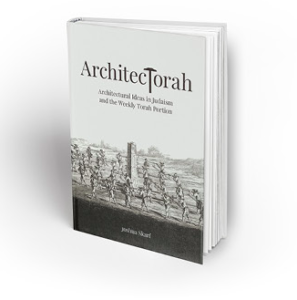
BOCA RATON, Florida — Urim Publications published “ArchitecTorah, Architectural Ideas in Judaism and the Weekly Torah Portion” by Joshua Skarf in 2023. It contains 178 short, informative, easy-to-read essays on the 54 weekly portions focusing on Torah topics that reveal hidden information about God and architecture design and theory in his 594-page book.
In the first two parashas of Exodus, for example, there are four and three discussions. At the outset of Exodus, for instance, he notes that ancient commentators in Midrashim see that the Torah does not reveal how the Egyptians started the enslavement of the Israelites. The Midrashim give imaginative notions, such as that Pharaoh himself began to work, and the Israelites felt they should courteously help him. Pharaoh then withdrew and forced the Israelites to continue. He tells us how the Roman emperor Vespasian used a similar trick. He also writes that ground-breaking and cornerstone ceremonies involve building owners similarly to add dignity to the work, motivate better performances, and solicit funds.
 In another chapter, he focuses on Pharaoh ordering midwives to murder newborn Israelite boys. They refused because they feared God, and “he made them houses.” Two items are obscure. We do not know who the “he” is and the nature of the houses. Interpretations differ. In one, God gives the women metaphorical houses, dynastic lines of priests and kings. Others say it was Pharaoh who placed the midwives under house arrest. Still others suggest Pharaoh built houses for Egyptians in Israelite neighborhoods to spy on the Israelites. Skarf discusses Joseph’s plan to settle his family in Goshen, apart from the Egyptians, and the current desire of many Jews to live in Jewish neighborhoods.
In another chapter, he focuses on Pharaoh ordering midwives to murder newborn Israelite boys. They refused because they feared God, and “he made them houses.” Two items are obscure. We do not know who the “he” is and the nature of the houses. Interpretations differ. In one, God gives the women metaphorical houses, dynastic lines of priests and kings. Others say it was Pharaoh who placed the midwives under house arrest. Still others suggest Pharaoh built houses for Egyptians in Israelite neighborhoods to spy on the Israelites. Skarf discusses Joseph’s plan to settle his family in Goshen, apart from the Egyptians, and the current desire of many Jews to live in Jewish neighborhoods.
In the second parasha, to cite other interesting examples, Skarf points out that none of the ten plagues designed to punish the Egyptians and show God’s power did anything to Egyptian temples and idols. Why? He refers us to the Babylonian Talmud Avodah Zara 54b, which states that destroying temples and idols does not uproot idol worship. It is necessary to get people to recognize God. He follows up by telling readers the Jewish view that a building, even one devoted to idols, is not in itself unethical.
In another chapter, he notes how the plague of frogs invaded Egyptian houses. Why, he inquires, is there an emphasis on homes? He discusses the view of Rabbi S. R. Hirsch that the Egyptians lorded over their slaves for many years and were now getting their comeuppance. The slaves owned no place of their own. He also discusses the sanctity of the home in Judaism, how the plagues passed over the Israelites’ houses, the Passover law to rid homes of leaven, and other laws involving the importance of homes.
In short, this book is both fascinating and enlightening. It is well worth reading.